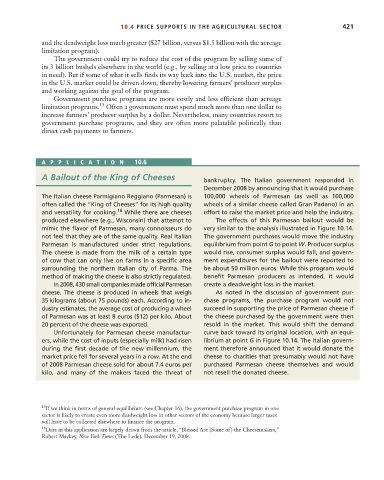Page 447 - Microeconomics, Fourth Edition
P. 447
c10competitive markets applications.qxd 7/15/10 4:58 PM Page 421
10.4 PRICE SUPPORTS IN THE AGRICULTURAL SECTOR 421
and the deadweight loss much greater ($27 billion, versus $1.5 billion with the acreage
limitation program).
The government could try to reduce the cost of the program by selling some of
its 3 billion bushels elsewhere in the world (e.g., by selling at a low price to countries
in need). But if some of what it sells finds its way back into the U.S. market, the price
in the U.S. market could be driven down, thereby lowering farmers’ producer surplus
and working against the goal of the program.
Government purchase programs are more costly and less efficient than acreage
limitation programs. 15 Often a government must spend much more than one dollar to
increase farmers’ producer surplus by a dollar. Nevertheless, many countries resort to
government purchase programs, and they are often more palatable politically than
direct cash payments to farmers.
APPLICA TION 10.6
A Bailout of the King of Cheeses bankruptcy. The Italian government responded in
December 2008 by announcing that it would purchase
The Italian cheese Parmigiano Reggiano (Parmesan) is 100,000 wheels of Parmesan (as well as 100,000
often called the “King of Cheeses” for its high quality wheels of a similar cheese called Gran Padano) in an
and versatility for cooking. 16 While there are cheeses effort to raise the market price and help the industry.
produced elsewhere (e.g., Wisconsin) that attempt to The effects of this Parmesan bailout would be
mimic the flavor of Parmesan, many connoisseurs do very similar to the analysis illustrated in Figure 10.14.
not feel that they are of the same quality. Real Italian The government purchases would move the industry
Parmesan is manufactured under strict regulations. equilibrium from point G to point W. Producer surplus
The cheese is made from the milk of a certain type would rise, consumer surplus would fall, and govern-
of cow that can only live on farms in a specific area ment expenditures for the bailout were reported to
surrounding the northern Italian city of Parma. The be about 50 million euros. While this program would
method of making the cheese is also strictly regulated. benefit Parmesan producers as intended, it would
In 2008, 430 small companies made official Parmesan create a deadweight loss in the market.
cheese. The cheese is produced in wheels that weigh As noted in the discussion of government pur-
35 kilograms (about 75 pounds) each. According to in- chase programs, the purchase program would not
dustry estimates, the average cost of producing a wheel succeed in supporting the price of Parmesan cheese if
of Parmesan was at least 8 euros ($12) per kilo. About the cheese purchased by the government were then
20 percent of the cheese was exported. resold in the market. This would shift the demand
Unfortunately for Parmesan cheese manufactur- curve back toward its original location, with an equi-
ers, while the cost of inputs (especially milk) had risen librium at point G in Figure 10.14. The Italian govern-
during the first decade of the new millennium, the ment therefore announced that it would donate the
market price fell for several years in a row. At the end cheese to charities that presumably would not have
of 2008 Parmesan cheese sold for about 7.4 euros per purchased Parmesan cheese themselves and would
kilo, and many of the makers faced the threat of not resell the donated cheese.
15 If we think in terms of general equilibrium (see Chapter 16), the government purchase program in one
sector is likely to create even more deadweight loss in other sectors of the economy because larger taxes
will have to be collected elsewhere to finance the program.
16 Data in this application are largely drawn from the article, “Blessed Are (Some of ) the Cheesemakers,”
Robert Mackey, New York Times (The Lede), December 19, 2008.

